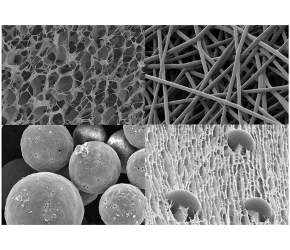Gold Nanoparticles Improve Cellular Signaling in Novel Heart Repair Tissue
By LabMedica International staff writers
Posted on 09 Oct 2014
An Israeli research team has developed a novel gold nanoparticle-based approach for repairing damaged heart tissue.Posted on 09 Oct 2014
Human heart cells cultured on ECM (extracellular matrix) scaffoldings of animal origin (usually pig) form a tissue that generates its own electrical impulses and expands and contracts spontaneously. However, residual proteins and antigens from animal sources can trigger pathogenic immune responses following implantation of these tissues.

Image: Biomaterials were designed to specifically accommodate cardiac, neuronal, and stem cells. The biomaterials temporarily replace the native ECM, providing support and instructive cues to the developing tissues. Post implantation the biomaterial degrades leaving the engineered tissue to stand on its own (Photo courtesy of Tel Aviv University).
Investigators at Tel Aviv University (Israel) avoided the immune response problem by constructing scaffolding from a patient's own stomach wall tissue. In a further refinement, they integrated gold nanoparticles into this hybrid cardiac tissue in order to optimize electrical signaling between the cells.
Results published in the September 1, 2014, online edition of the journal Nano Letters revealed that cardiac cells engineered within these hybrid scaffolds exhibited elongated and aligned morphology, massive striation, and organized connexin 43 electrical coupling proteins. Furthermore, the hybrid patches demonstrated superior function as compared to pristine patches, including a stronger contraction force, lower excitation threshold, and faster calcium transients.
"Our goal was twofold," said senior author Dr. Tal Dvir, professor of molecular microbiology and biotechnology at Tel Aviv University, "to engineer tissue that would not trigger an immune response in the patient and to fabricate a functional patch not beset by signaling or conductivity problems. To address our electrical signaling problem, we deposited gold nanoparticles on the surface of our patient-harvested matrix, "decorating" the biomaterial with conductors. The result was that the nonimmunogenic hybrid patch contracted nicely due to the nanoparticles, transferring electrical signals much faster and more efficiently than non-modified scaffolds. We now have to prove that these autologous hybrid cardiac patches improve heart function after heart attacks with minimal immune response. Then we plan to move it to large animals and after that, to clinical trials."
Related Links:
Tel Aviv University














